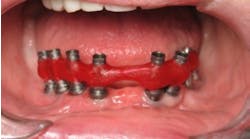Retirement planning for dentists: Investing today for a better tomorrow
When patients sit in our dental chairs, they trust us to treat their dental maladies while often blind to the process. Would you treatment plan a case without contemplating thoroughly the end result? Do you commence treatment on a patient prior to discussing your plan for that treatment? Do you establish expectations to make sure your and your patients’ vision are congruent with each other? As we review our patients’ medical and dental histories, as well as their chief complaints, a number of thoughts and possible solutions automatically enter our minds. It is only when we hear details from them directly that we get better insight into their concerns and can then begin to frame a long-term treatment plan. I inform my patients about what our treatment will entail, how long it will take, and what results they realistically can expect to achieve.
I am somewhat surprised that many doctors reserve this treatment for their patients but do not apply it to their own lives. A practice — and your work — is a living, breathing business that needs to be cared for to make sure you, as its head, get out of it everything you hope. To live the lives we want to live in five, 10, or 30 years, we need to start planning, and we need to start doing it today. One of the most effective ways to seed this goal is to establish a retirement plan. The options are plenty, and the impact can be life changing. If you ever want to retire to the beach, drive a luxury car, or work on your golf swing, it is important to understand both the how and the why of just a few of the relevant retirement plans available to dental professionals.
ALSO BY DR. JENNIFER HIRSCH DOOBROW |Biomimetic technology: putting the tooth fairy out of business
Benefits of a plan
We all know we need to save for retirement, but what does the plan do for both you and your team members? While it may seem like something that can be addressed later, how many of us have thought about the real comprehensive benefits of putting a plan in place and how it improves our practices?
(1) Employee satisfaction — From a business standpoint, employees want to work somewhere they feel appreciated and have solid benefits. What better way to show them how much you care than by helping them plan for their long-term dreams as well? Increased satisfaction leads to increased loyalty and reduced turnover, helping your practice run smoother. New hires cost you between $10,000 and $25,000 to train, in addition to tackling the initial awkwardness of adjusting to a new personality in the office. We should not dismiss the importance of reducing employee turnover.
(2) Tax-reducing expense — Many retirement plans require a small, employer-sponsored contribution or salary match. At first blush you may think that is just more money out of your pocket, but these contributions are indeed a taxable expense. This is prudent spending as you can deduct the line item from the business’ net income at the end of the fiscal year. By helping your employees, you owe less in taxes.
(3) Pretax contributions— When contributing money to qualified retirement plans, the contributions are done so on a pretax basis. This allows you to save more and reduce your personal net income, owing less than you would on tax day without them. As a very simple example, assume a young dentist makes $100,000 and has no retirement plan. At the end of the year, she reports $100,000 of income and the 28% tax bracket that would result in $28,000 in taxes due for take-home pay of $72,000. On the contrary, assume that same dentist has a plan that allows her to contribute up to 25% of her salary. Now she has $25,000 in her plan and a taxable income of only $75,000. At 28% tax bracket, she would owe $21,000, a direct savings of $4,000. Which would you rather have?
(4) Tax-deferred growth— There is a saying that “compounding interest is the Eighth Wonder of the World” and no better plan proves this than retirement accounts. We already managed to avoid a substantial amount of taxes by putting money into our plan, and now we get to enjoy tax-deferred, compounding growth. This means that as our money grows year-to-year, we will never pay taxes on the interest, dividends, or capital gains our investments generate until we take withdrawals and we are (hopefully) in a lower tax bracket. Who wants to pay more in taxes?
Types of plans
Once you realize you need a plan, there are multiple options to choose from. Three of the most popular for small businesses are the 401(k), the SEP IRA, and the SIMPLE IRA. Each have their own requirements, and you will want to discuss your options with an accountant and/or a financial advisor to figure out which plan is right for your practice. Do not be afraid to ask questions; your patients have likely asked you every question you could imagine (and some you could not), so do not be afraid to ask about even the smallest of details. This is your money, your future, and your business.
Conclusion
As dentists and specialists, we need to challenge ourselves not to only invest our time and energy into our patients’ lives but also our own. The time to save is ticking by every day, but your target retirement day continues to get closer. If you put this off any longer, there are only three options that you will have to make up for lost time, and I do not like any of them. Choice 1: Save more. Choice 2: Work longer. Choice 3: Reduce your lifestyle expenses. You work hard to make sure your patients and team members are happy; make sure you take care of the face in the mirror as well.









